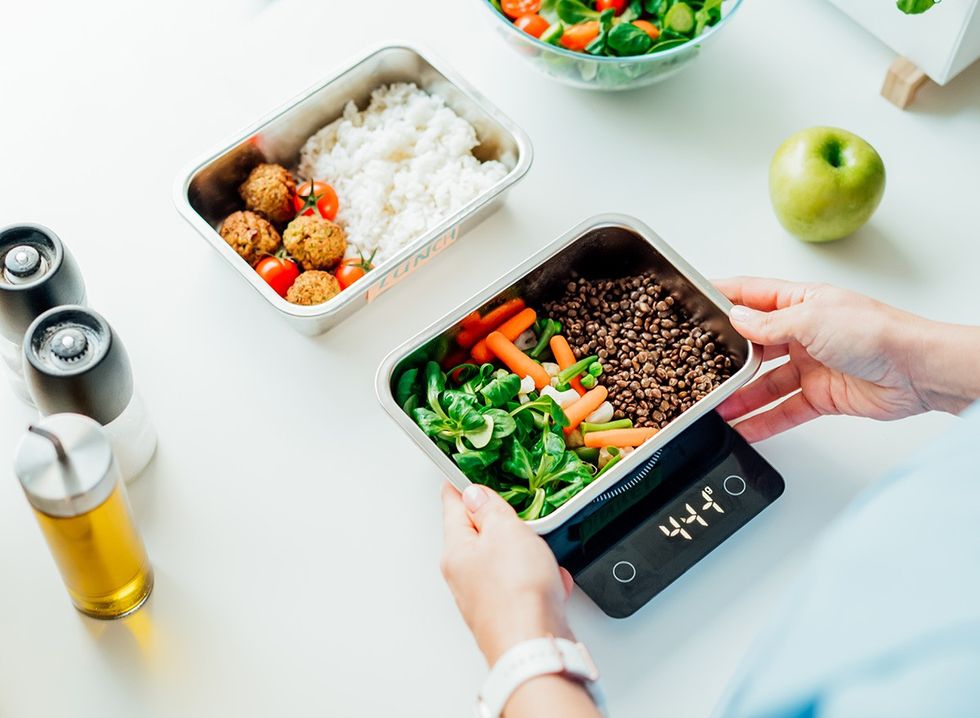Wanting to look better in bed? You're not alone. "More than half of Americans feel pressured to have a certain body type, with 23% actively experiencing body dysmorphia and 20% having experienced it in the past. Yet, every body type is attractive and desired — and the vast majority of people aren’t looking for perfection anyway," says the dating app Pure. Their recent survey showed that "nobody is hitting pause on the foreplay to search their partner’s body for imperfections. In fact, 71% of Americans have never bailed on sex after their partner strips down." that said, you of course want to feel confident about your body in bed if possible. Here are 5 ways to look better in bed, no matter how you look.
1. This is the Essential First Step
 Shutterstock
Shutterstock
"Feeling good about yourself in any context–including in the bedroom–starts with a strong base of positive healthy habits," says Catherine Rall, Registered Dietitian, Happy V. "Getting enough sleep each night and consistently eating a balanced, healthy diet that includes plenty of vitamins, minerals, antioxidants, and hydration is going to make you feel physically better, and take your mood and self-image up along with it. This isn’t going to magically resolve any body image issues you may have, nor is it going to automatically build a strong relationship with your partner, but it’s an essential first step."
2. Indeed, Your Mental and Physical State are Linked
 Shutterstock
Shutterstock
"As a personal trainer, I often remind people how their mental state and their physical state are intrinsically linked. You can't separate them," says David Rosales, NSCA-CPT, of Roman Fitness Systems. "No matter what fancy techniques you can get into, you have to do the basics for your physical body, that put you mentally in a good state. Here are the two biggest in my opinion.
1) Sleep. Nothing will help you feel better about everything than consistent good sleep.Put your phone away 60 minutes before bed. Scrolling social media is where good sleep goes to do.
2) Have a consistent sleep routine. It's easier to fall asleep if you're used to falling asleep at that time. And prioritize it! Most importantly, commit to making sleep a priority, otherwise, you'll always struggle with it.
2) Movement. Of course, you could focus on strength training here, but if you're lacking internal mental confidence, one of the best things for your mood is to just go on a walk. As a tactical step, I recommend the "zero-zero" approach. That is, make sure you have zero days with zero movement. Even a 5-minute walk counts.
Related: 13 Diet Tips That Help Firm Up Your Butt
3. These Exercises Could Help Your Appearance in Bed
 Shutterstock
Shutterstock
Improving your appearance in bed is no different than improving your appearance not in bed. Your program should focus on compound movements (squats, split squats, deadlifts, pushing, and pulling) rather than focusing on "mirror" muscles. For in-bed and out-of-bed performance, lifting weights is important to optimize your hormones, specifically testosterone. So challenge yourself with the weights. Don't neglect cardio. Aim for three sessions of minutes per week. All of this will help you feel better in bed and life.
A fitness routine could contribute to improved self-confidence and body image in bed. This can really vary by person. Here are some possible ways it can help.
- Improves physical strength and stamina, leading to more confidence.
- Improves mood (exercise is magic!) therefore leading to confidence.
- Gives you confidence that you can perform in all areas of life, including in bed.
- Again, nutrition will help you everywhere. It will help you build muscle, lose fat, and improve blood flow (very important in bed).
4. Do Your Kegels
 Shutterstock
Shutterstock
"As a certified yoga teacher turned strength training coach with over 8 years of experience teaching women of all ages I have found the following to be my most valuable advice," says Thalia Stefania (@thaliastefaniafit). "Looking better in bed is not only physical but also about attitude.
- Strength training is not only important for sculpting a sexy body, strengthening through exercises like squats, push-ups, and plank will also help you feel more confident in all sorts of positions.
- Flexibility can be gained through exercises like yoga and Pilates, to help you be more graceful during the more complicated sexual encounters.
- Doing cardio activities like running or cycling you get toned abs but also last for hours.
- Finally, if you're aiming to look and feel better, pelvic floor exercises like Kegels are your ticket to increased sexual performance and those oh-so-desirable O's."
Kegel exercises, which strengthen the pelvic floor muscles, are performed similarly for both men and women, though the focus might slightly differ due to anatomical differences.
For Women:
- Identify the Correct Muscles: The easiest way to do this is to try to stop your urine flow mid-stream. The muscles you use for this action are your pelvic floor muscles. However, this is just for identification purposes; don't regularly do Kegels while urinating as it can lead to urinary issues.
- Find a Comfortable Position: You can do Kegels lying down, sitting, or standing.
- Contract and Relax: Tighten your pelvic floor muscles, hold the contraction for three to five seconds, and then relax for three to five seconds. Try it four or five times in a row. As you get more comfortable, you can gradually increase the duration of the contractions and the relaxation.
For Men:
- Identify the Pelvic Floor Muscles: Similar to women, a good way to find them is by stopping urination mid-stream or tightening the muscles that prevent you from passing gas.
- Perfect Your Technique: Contract these muscles, hold the contraction for a count of three, and then relax. Ensure you're focusing solely on the pelvic floor muscles without contracting the abdomen, thighs, or buttocks.
- Maintain Your Focus: Breathe freely during the exercises and maintain your focus on contracting only the pelvic floor muscles.
General Tips:
- Frequency: Aim to do at least three sets of 10-15 repetitions a day.
- Regular Practice: The benefits of Kegel exercises are seen over time, so it's important to make them a regular part of your routine.
- Avoid Overdoing It: Just like any other muscular workout, it’s important not to overdo Kegels. Overworking the pelvic floor muscles can lead to muscle fatigue and increase urinary issues.
It's recommended to consult with a healthcare provider for personalized guidance, especially if you have existing health issues or are unsure about the correct technique.
Related: I Lost 70 Pounds After Stop Doing These 7 Things
5. One Tip You've Never Considered: Visit Different Countries
 Shutterstock
Shutterstock
"As a multi-experienced entrepreneur and fitness enthusiast, I have learned that confidence affects various aspects of our lives, including intimacy. A proven way to build this confidence lies in physical and mental fitness," says Yulia Saf, known as Miss Tourist. "First, regular exercise, such as pilates and yoga, improves body flexibility and strength, enhancing body image perception and boosting confidence in bed. Second, traveling or living in different countries can expose one to diverse body beauty standards, fostering more acceptance and appreciation of one's own body. Lastly, fostering a growth mindset encourages continuous self-improvement and focuses less on imperfections and more on progress, significantly improving self-confidence in intimate moments. I believe that fitness is very holistic: the mind, body, and spirit must be in sync for a person to genuinely feel good about themselves, not only mentally but also physically."
💪🔥Body Booster: No matter what fancy techniques you can get into, you have to do the basics for your physical body, that put you mentally in a good state.























 Shutterstock
Shutterstock Shutterstock
Shutterstock Shutterstock
Shutterstock Shutterstock
Shutterstock Shutterstock
Shutterstock Shutterstock
Shutterstock Shutterstock
Shutterstock Shutterstock
Shutterstock
 Shutterstock
Shutterstock Shutterstock
Shutterstock Shutterstock
Shutterstock Shutterstock
Shutterstock Shutterstock
Shutterstock
 Shutterstock
Shutterstock Shutterstock
Shutterstock Shutterstock
Shutterstock Shutterstock
Shutterstock Shutterstock
Shutterstock Shutterstock
Shutterstock Shutterstock
Shutterstock Shutterstock
Shutterstock Shutterstock
Shutterstock
 Shutterstock
Shutterstock Shutterstock
Shutterstock Target Side Core MusclesShutterstock
Target Side Core MusclesShutterstock 5. Glute BridgesShutterstock
5. Glute BridgesShutterstock Space and Means Haves: Squat Rack, Smith Machine ComboShutterstock
Space and Means Haves: Squat Rack, Smith Machine ComboShutterstock Shutterstock
Shutterstock 5 Exercises You Can Do Without Leaving Your DeskShutterstock
5 Exercises You Can Do Without Leaving Your DeskShutterstock

 I'm a Nutritionist and These 9 High-Protein Snacks Keep My Clients Full While Losing 50 Pounds
I'm a Nutritionist and These 9 High-Protein Snacks Keep My Clients Full While Losing 50 Pounds
 Shutterstock
Shutterstock 2. Processed FoodsShutterstock
2. Processed FoodsShutterstock Shutterstock
Shutterstock Shutterstock/Prostock-studio
Shutterstock/Prostock-studio Shutterstock
Shutterstock Pro TipsShutterstock
Pro TipsShutterstock Shutterstock
Shutterstock Shutterstock
Shutterstock Shutterstock
Shutterstock Shutterstock
Shutterstock Don’t Drink as Much AlcoholShutterstock
Don’t Drink as Much AlcoholShutterstock Most Women on GLP-1s Are Making a Few Common MistakesShutterstock
Most Women on GLP-1s Are Making a Few Common MistakesShutterstock Soda and Sugary DrinksShutterstock
Soda and Sugary DrinksShutterstock Shutterstock
Shutterstock Eat BreakfastShutterstock
Eat BreakfastShutterstock And Improve Insulin SensitivityShutterstock
And Improve Insulin SensitivityShutterstock Belly Flab Strip Tip: Sugar and Fat Calories Leave Its Mark on Your BodyShutterstock
Belly Flab Strip Tip: Sugar and Fat Calories Leave Its Mark on Your BodyShutterstock Shutterstock
Shutterstock The Drugs Mimic the GLP-1 Hormone Naturally Produced by the BodyShutterstock
The Drugs Mimic the GLP-1 Hormone Naturally Produced by the BodyShutterstock 3. Deep-Fried ItemsShutterstock
3. Deep-Fried ItemsShutterstock